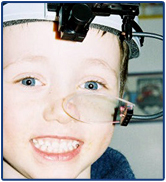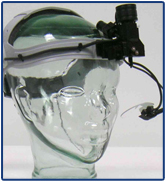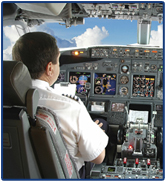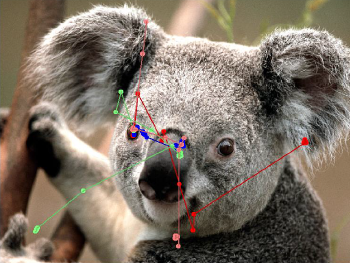ETServer Eye Tracking System
 The ETServer system is especially suited to applications requiring precise, high update rate, point-of-gaze or pupil diameter measurements under very flexible conditions in indoor environments. Data update rates from 60 to 360 Hz are supported.
The ETServer system is especially suited to applications requiring precise, high update rate, point-of-gaze or pupil diameter measurements under very flexible conditions in indoor environments. Data update rates from 60 to 360 Hz are supported.
Both head mounted and chin rest mounted optics are available.
Either head mounted or chin rest mounted optics are connected to a desktop PC containing all eye tracker electronics. Bright pupil optics provide optimal eye feature contrast for indoor conditions, and sophisticated image processing algorithms find the eye features automatically and accurately to compute line-of-gaze and pupil diameter.
An ellipse is fit to the pupil image outline so that, as the eye rotates, apparent changes in ellipticity of the pupil image (circle appears elliptical when viewed from an angle) do not affect either the pupil diameter measurement or the accuracy of the pupil center determination.
 Head mounted optics are attached to a lightweight adjustable headband, and have adjustments with multiple degrees of freedom, including an infra red reflective beam splitter mounted on a flexible wire. This allows the camera to view the eye from many different angles to accommodate participants wearing eyeglasses of different types, or situations where the primary field of view may not be straight ahead. Use of the beam splitter means that the eye camera never occludes the field of view, and peripheral vision is completely unobstructed.
Head mounted optics are attached to a lightweight adjustable headband, and have adjustments with multiple degrees of freedom, including an infra red reflective beam splitter mounted on a flexible wire. This allows the camera to view the eye from many different angles to accommodate participants wearing eyeglasses of different types, or situations where the primary field of view may not be straight ahead. Use of the beam splitter means that the eye camera never occludes the field of view, and peripheral vision is completely unobstructed.
The standard (60 Hz) head mounted optics unit weighs 12 ounces (339 grams), and can be comfortably worn by participants 4 years and older. With the high-speed option (120/240/360 Hz), the unit weighs 14 ounces (395 grams).
The head mounted or chin rest mounted optics connect to the ETServer PC with a standard 15 ft. (4.57 meter) cable. (Up to 50 ft. cable is optional). The system is ideal for either seated participants or participants who will walk about in a limited area.
 Gaze can be determined with respect to either the image from a head mounted scene camera; or, if the ET3Space feature is used, with respect to a real world 3 dimensional coordinate system. If ET3Space is used, the ETServer system can display real-time point-of-gaze (POG) superimposed on the image from a stationary (room mounted) scene camera. If the stimulus is a Win 7 or Win 10 computer display, the real-time POG cursor can be superimposed directly on a copy of the display image that is streamed to the eye tracker by the Argus Science ETRemote application.
Gaze can be determined with respect to either the image from a head mounted scene camera; or, if the ET3Space feature is used, with respect to a real world 3 dimensional coordinate system. If ET3Space is used, the ETServer system can display real-time point-of-gaze (POG) superimposed on the image from a stationary (room mounted) scene camera. If the stimulus is a Win 7 or Win 10 computer display, the real-time POG cursor can be superimposed directly on a copy of the display image that is streamed to the eye tracker by the Argus Science ETRemote application.
 The ETServer system can integrate with numerous commercially available position tracking systems to implement the Argus Science ET3Space function. Argus Science StimTrac and SceneMap functions are also supported, along with Argus Science ETAnalysis software.
The ETServer system can integrate with numerous commercially available position tracking systems to implement the Argus Science ET3Space function. Argus Science StimTrac and SceneMap functions are also supported, along with Argus Science ETAnalysis software.
If the chin rest mounted optics are used, the optics assembly can be equipped with a precision focusing mechanism to allow accurate measurement of absolute pupil diameter as well as gaze direction.
Features
Precise, high speed measurement (up to 360 Hz).
Flexible camera-to-eye optical path to accomodate different primary fields of view, with no visual field occlusion.
Pupil diameter measurement not affected by image ellipse distortion as eye rotates.
Incredibly fast and simple setup.
Quick and easy subject calibration.
Participant movement constrained only by 25 ft (7.6 m), or optionally up to 100 ft., cable.
Eye and Scene images displayed on a single monitor with constant real-time feedback showing point-of-gaze and system feature recognition performance.
Argus Science ET3Space feature, with external head tracker, to find line-of-gaze with respect to 3 dimensional environment coordinates, and point-of-gaze on multiple stationary surfaces.
Real-time display of gaze on stationary scene camera image with ET3Space.
Optional Argus Science StimTrac or SceneMap features to analyze gaze with respect to stationary surfaces, without use of an external head tracker.
Automatic feature recognition with manual overrides for challenging participants.
Versatility in stimulus display devices accomodated - monitor, multiple monitors, TV, projected images, mulitiple real world objects, etc.
Flexible and powerful data analysis with Argus Science ETAnalysis software.
Chin rest mounted mounted optics are available for precise measurement of gaze on a single display, and precise measurement of absolute pupil diameter.
Real-time network communication with external devices.